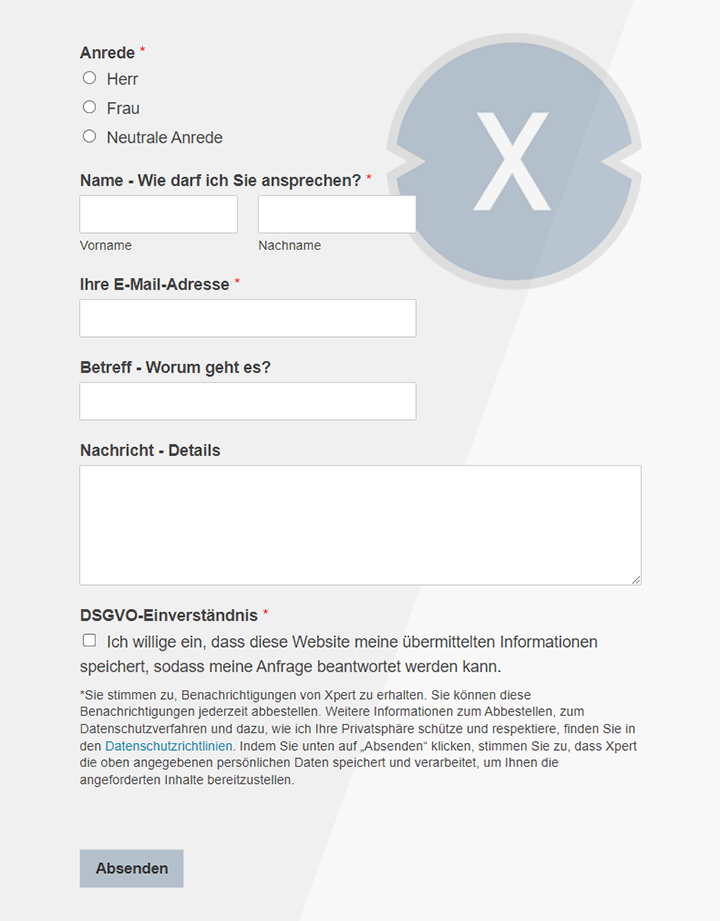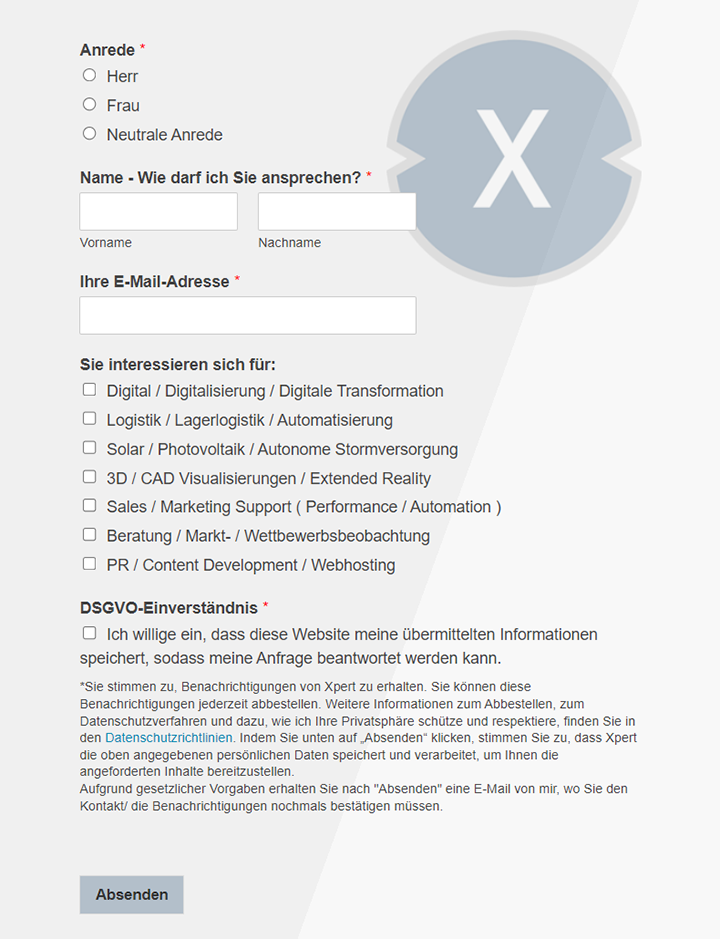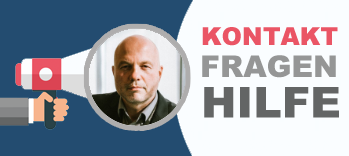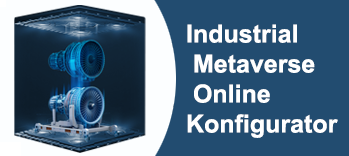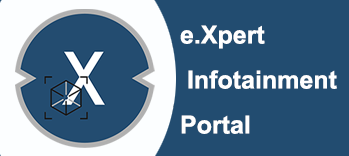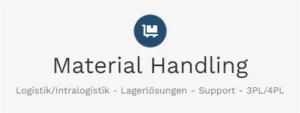AI-based B2B platform in mechanical engineering: This is how you crack the skeptical middle class with the proof-of-confept (POC) solution
Xpert pre-release
Language selection 📢
Published on: May 27, 2025 / update from: May 27, 2025 - Author: Konrad Wolfenstein

AI-based B2B platform in mechanical engineering: This is how you crack the skeptical middle class with the proof-of-confept (POC) solution-Image: Xpert.digital
Proof-of-Concept: The secret of successful AI projects in mechanical engineering-strategic plan for customer acquisition
Proof-of-Concept: The key to accepting AI platforms
The development of the German and European mechanical engineering market for a AI-based B2B platform requires a profound understanding of the industry-specific conservativity, the pronounced sensitivity in terms of data security and intellectual property as well as the dominant role of pragmatic, risk-loving medium-sized stand. A successful market penetration and customer acquisition depends crucially on a strategy that takes these factors into account and builds up trust.
At the center of this strategy is the Proof-of-Concept (POC). The POC not only serves as a pure demonstration instrument, but as a central pillar to create trust, validate the return on investment (ROI) and minimize perceived risks. The design of the POC must be precisely tailored to the specific concerns of the industry, especially with regard to data security, IP protection, system integration and the proof of clear economic use.
The Go-to-Market strategy should be multifaceted and targeted digital content, the strategic use of industry networks such as the VDMA (Association of German Machine and Plant Construction) and important leading fairs such as the Hannover Mess as well as the establishment of direct sales relationships or partnerships. Targeted marketing messages must address the specific challenges and opportunities of mechanical engineering in the context of digitization and AI adoption.
Sustainable market entry and customer acquisition are based on a strategy that shows deep empathy for the operational realities and cultural values of the target group and offers tangible, safe and gradual integrable solutions. The ability to present the benefits of the AI platform in concrete and understandable will be the key to success. This report outlines the necessary steps and strategic considerations to achieve these goals.
Suitable for:
- Why mechanical engineering is hesitating: challenges and potential of Asian B2B platforms such as ACCIO from Alibaba
Navigation of the German and European mechanical engineering landscape for AI solutions
Market dynamics and key characteristics (Germany as a hub, SME dominance)
A well -founded understanding of the target market is essential for the development of a successful acquisition strategy. Germany occupies an outstanding position in European mechanical engineering and contributes 27 % to the overall production of the EU. This positions Germany as a primary bridgehead market. The success of large German companies such as Bosch, Claas, Siemens and Krones sets a high standard for innovation and quality, which shapes the expectations of the entire sector.
The structure of the industry, especially in Germany, is strongly shaped by small and medium -sized companies (SMEs), the so -called medium -sized company. Remarkable 95 % of the approximately 6,600 German mechanical engineering companies employ fewer than 500 employees. This SME dominance requires acquisition strategies that are finely tailored to the specific operating models, resource restrictions and decision-making agility. A further breakdown of the company sizes shows that 62.6 % of German mechanical engineering SMEs generate sales of up to 2 million euros, another 22.7 % up to 10 million euros. This underlines the need for AI solutions that offer a clear, fast ROI and whose introduction and integration are not associated with prohibitive costs.
A decisive feature of these medium -sized companies is their profound specialization, which often leads to global market leadership in niche segments. On the one hand, this results in a strong internal innovation culture, but on the other hand also increased vigilance with regard to the protection of their unique intellectual property-a central concern for every B2B platform that processes its data. The pronounced niche specialization and export orientation of the German middle class thus places a double requirement for a AI-based B2B platform. These companies, often “hidden champions” on the world market, owe their success unique innovations and profound market knowledge in specific segments. Their intellectual property is invaluable. Since a Ki-B2B platform naturally processes company data that can include sensitive design, process or customer information for these companies, the platform's promise of value must go beyond pure efficiency increases. It must intrinsically address the security of intellectual property and show how the platform contributes to protecting or even strengthening its innovation advantage in global markets. A non -fulfillment of this requirement will encounter considerable resistance.
The internal market of the European Union is of outstanding importance; 45 % of all German machine exports go to EU partners. France (16 %), Italy (11 %), Poland (10 %), the Netherlands (10 %) and Austria (9.5 %) are the main customers. This complex network of intra -European trade shows logical ways for a gradual European expansion after a successful German market entry. The significant export deflecting between Germany and other important EU nations suggest that a “lighthouse customer” strategy in Germany, especially with SMEs, which have strong connections to these nations, can make it organically easier to enter the following European market entry. Business relationships in industrialectors are often based on networks and trusting recommendations. If a German SME successfully introduces the Ki-B2B platform and benefits from it, its international partners and customers will probably be aware of this in these important EU markets. This creates a “pull” effect or at least a more receptive audience in these secondary sleeves, since the solution was validated by a trustworthy German counterpart. The strategy should therefore identify and prioritize German SMEs into these specific countries with strong export connections.
Profile of the German and European mechanical engineering market
The German and European mechanical engineering market is characterized by a clear profile: Germany contributes significantly to overall production in the EU with a share of 27 %, while important EU markets such as Italy, France 12 %, Spain 8 % and Poland 6 %. There are around 6,600 mechanical engineering companies in Germany, 95 % of which are small and medium-sized companies (SMEs) with fewer than 500 employees-a characteristic that is typical of many EU countries. The sales distribution of German SMEs shows that 62.6 % achieve annual sales of up to € 2 million, 22.7 % up to € 10 million, € 10.6 % up to € 50 million and 4.1 % over € 50 million. The most important European export targets for German machines are France (16 %), Italy (11 %), Poland (10 %), the Netherlands (10 %) and Austria (9.5 %), with 45 %of all German machine exports within the EU. The leading companies in the industry include well -known names such as Bosch, Claas, Dürr, Exyte, Festo, Krones, Voith, Zeiss, Siemens AG, GEA Group AG and Enercon GmbH, supplemented by national market leaders in the respective countries.
This table consolidates critical statistics and illustrates the leading role of Germany and the prevalence of SMEs, which underlines the need for a SME-centered strategy. The identification of the most important EU export markets for German goods helps prioritize subsequent expansion efforts and informs directly about market size determination, segmentation, targeting and resource allocation decisions for the provider of the Ki-B2B platform.
The AI adoption dilemma: hurdles and reservations in the industry
The reserved AI adoption curve in mechanical engineering is due to multi-layered reasons that need to be analyzed.
Overarching concerns: data security, IP protection and data sovereignty
These are not only technical, but “existential fears” for innovation-dependent mechanical engineering companies. The strict EU regulation (GDPR, Data Act, NIS2, Cyber Resilience Act) tightens this concerns, especially with regard to non-European platforms and potential IP theft or industrial espionage. The VDMA shares these concerns regarding the rules for data use.
Digitization contracts and old systems
A widespread “slower and cautious approach in digitization” characterizes many German mechanical engineering companies that often fight “outdated structures” and an “inadequate data -controlled way of working”. This conservative attitude is nourished by perceived costs, a lack of specialists and a general reluctance to faster digital adaptation. By 2023, only 10 % of the manufacturing companies were used by AI. The “conservative attitude”, which prevails in German mechanical engineering, is not arbitrary resistance to changes, but a deeply rooted cultural train that results from a business model, in which precision, long -term reliability and the protection of hard -developed innovations come first. New technologies are considered by the glasses of potential risks for these core principles, especially with regard to their invaluable intellectual property. The hesitation is therefore a rational risk management reaction, which is not purely emotionally, but in the possibility that new technologies could disrupt successful, successful models if they are not implemented with extreme care.
Suitable for:
The qualification gap: lack of specialist staff and digital know-how
This is a considerable obstacle. A Bitkom study shows that 76 % of German production companies see the availability of qualified personnel as a central challenge for AI adjustment compared to 57 % in the entire EU. This deficit creates a “vicious circle” because it affects the ability to evaluate, adapt and use advanced digital tools, which increases skepticism. The identified qualification gap goes beyond a pure lack of data scientists; It critically includes a lack of strategic understanding at the management level of how AI can be used effectively in order to achieve specific business results. If decision -makers do not fully grasp the strategic potential of AI or the timetable for their integration, it is unlikely that they are promoted their introduction or provide the necessary resources. As a result, the provider of the Ki-B2B platform has to offer more than just a highly developed tool; He also has to show a clear path to strategic integration and further training.
Unclear about benefits and AI-ready level
A considerable number of companies are still “uncertain about the expected benefit” and has “concerns about the maturity and reliability of AI”. This skepticism must be addressed with concrete evidence.
Suitable for:
Financial constraints and investment priorities
Rising energy and personnel costs as well as significant investment requirements for environmentally friendly technologies often direct resources from long-term digitization projects. The advance costs for the implementation of AI platforms (software, training, process adjustment) are a central barrier, especially if economic uncertainty dampens the willingness to invest in projects with less direct or tangible ROI.
Complexity of system integration
An effective introduction requires a “deep technical localization” that goes beyond the pure language translation. This includes seamless integration into existing, often deeply anchored company systems (ERP, PLM, SCM) and compliance with specific industrial data standards such as OPC UA.
Caution to non-EU platforms and the pursuit of digital sovereignty
Causes regarding data control, dependence on non-European cloud providers and a recognizable preference for European-centered solutions (e.g. GAIA-X, Catena-X Initiatives) create additional hurdles for platforms that are perceived as external to the EU ecosystem. The European initiative for “digital sovereignty” and initiatives such as GAIA-X represent an important geopolitical and market-related mood. A non-European provider of a Ki-B2B platform will be confronted with an inherent disadvantage, unless he can convincingly explain that it corresponds to these European principles of data control and autonomy or that is overwhelming Promises that overcomes this concerns. Ignoring this current is a strategic misjudgment.
Suitable for:
- Higher ROI with Brand Ambassador and Consumer like Industry Influencer Marketing – B2B & B2C Whitepaper Analysis – Top Info
Understanding the “Mittelstands” mentality: decision-making for new technologies
The decision-making process in the German middle class has distinct characteristics that must be taken into account when organizing sales and POC strategies.
Ownership -managed culture and agile decision -making
In many medium -sized companies, the owners have full responsibility and the risk, which can lead to potentially faster, less hierarchical decision -making processes. If the promise of value and the safety benefits of a AI platform are well received by the owner, the POC permit and the subsequent introduction can be accelerated. The direct participation of the owners of decisions in the middle class is a double -edged sword: on the one hand, it can accelerate the introduction if the owner is convinced, but on the other hand, this also means that his personal assessment of the trustworthiness of the provider and the risk profile of the solution is strong. The POC and the sales talk must therefore be designed to build a strong personal relationship and directly address the strategic concerns of the owner.
Prioritization of long -term profitability and trust
Medium -sized companies are characterized by their striving for long -term success and continuity. They value stable, responsible relationships with employees, customers and business partners. This leads to a preference for technology providers who are perceived as a reliable long -term partner, not as a seller of short -lived solutions. The focus of the middle class on “long -term success” and “continuity” means that they not only procure a technology, but also select a strategic partner. The POC phase is the first “rehearsal” for this long-term relationship. Therefore, aspects such as the stability of the provider, its commitment to the German market, the quality of the support and a transparent roadmap for the further development of the AI platform are just as important as the direct POC results.
Pronounced customer orientation and market diversity
A strong regional connection and close interaction with customers enable medium -sized companies to react very quickly to market changes. AI solutions that have been shown to improve this customer orientation, increase the ability to react to the market or open up new ways of customer loyalty are highly valued.
Inherent risk aversion and analytical examination
The German corporate culture, especially in medium -sized companies, is characterized by risk aversion. Buyers are typically analytically, meticulously prepared and require factual, data-based reasons for investments, including detailed ROI projections and robust conformity documentation (CE, ISO, GDPR). Trust is of the greatest importance and is gradually acquired through proven performance and reliability.
Pragmatism and skepticism towards hype
There is a remarkable skepticism compared to the “propagated hype” compared to the “actual benefit” of new technologies. Medium -sized decision -makers must see tangible, practical results and clear operational advantages instead of being influenced by keywords.
Important internal stakeholders and their concerns
- Top management/leadership (owner/CEO): main focus on strategic effects, ROI, cost-benefit analysis, risk reduction and long-term business.
- IT department/Digital Transformation Leads: The main concerns are technical feasibility, seamless integration into the existing infrastructure (ERP, PLM, SCM), data security, compliance with industrial data standards and the management of internal qualification deficits.
- Procurement/supply chain management: emphasis on the Total Cost of Ownership (TCO), compliance with European quality and security standards (CE marking, ISO 9001), resistance of the supply chain and reliability of the platform for critical processes.
- Legal/compliance department: examination of data security protocols, IP protective measures, compliance with EU regulations (GDPR, data act, NIS2) and contractual security.
- Sales/marketing department: Interest in how the platform can improve market access, optimize customer relationship management and support culturally adapted communication in international markets.
Trigger for the introduction of innovations
Innovations in SMEs often arise organically from coping with challenges of the “normal daily business” and not from extensive formal F&-programs. AI solutions that offer clear, immediate improvements for existing operational weaknesses or enable significant increases in efficiency are therefore more likely to find it. The observation that innovations in SMEs often arise from the challenges of the “normal daily business” suggests that a POC laser focus on the solution of tangible, existing surgical weaknesses with clear, verifiable improvements in efficiency, cost reduction or quality should be presented instead of presenting high-abstracts or futuristic AI skills without immediate practical use. The POC must refer to your existing work processes and offer solutions for problems that you try to actively solve, which makes the ROI immediately and understandable.
🔄📈 B2B trading platforms support – strategic planning and support for exports and the global economy with Xpert.Digital 💡
Business-to-business (B2B) trading platforms have become a critical part of global trade dynamics and thus a driving force for exports and global economic development. These platforms offer significant benefits to companies of all sizes, particularly SMEs – small and medium-sized businesses – which are often considered the backbone of the German economy. In a world where digital technologies are becoming increasingly prominent, the ability to adapt and integrate is crucial to success in global competition.
More about it here:
Proof-of-Concept: How B2B Ki platforms trust and promote transparency
The strategic imperative of the Proof-of-Concept (POC) for AI platforms
Designing a convincing POC: addressing of central concerns (data security, IP, integration, ROI)
The conception of a Proof-of-Concept (POC) must aim to address the core concerns of potential customers directly and convincingly in mechanical engineering. The basic goal of a POC is to validate the feasibility and the detectable use of the Ki-B2B platform for specific, predefined use cases in mechanical engineering within a controlled, low-risk environment. The POC must go beyond a pure technical demonstration and become a practical validation exercise that uses real (or representative anonymous) data and reflects operational scenarios from everyday life.
Suitable for:
- Future Export – Digital platforms for mechanical engineering – How has global sales been so far and how can it be promoted?
Strengthening data security & IP protection in the POC
The implementation and presentation of robust data governance frameworks throughout the POC is crucial. This includes the demonstration of end-to-end encryption for data during the transfer and resting state, strict roll-based access controls and comprehensive audit trails for all data interactions. Compliance with the requirements of the GDPR, the Data Act and the NIS2 directive must be explicitly detailed and demonstrated in the operational context of the POC, including clear consent mechanisms if personal data are involved. If necessary, data anonymization techniques or differential data protection measures must be explained and demonstrated that are used to protect sensitive information, while at the same time enables meaningful AI processing during the POC. The transparent information about IP protection protocols is of crucial importance. Dummy data or thoroughly anonymized customer data should be used for the POC. Data localization guidelines that highlight EU-based data centers for processing and storage must be clearly formulated in order to meet the preferences regarding data sovereignty. The POC serves as a primary “trust formation mechanism” for German medium -sized companies. His implementation, transparency and the responsiveness of the provider during this phase are just as critical as the technical results. Every interaction is a sample for a long -term partnership. A technically perfect POC can fail if the customer perceives a lack of commitment, poor communication or an inadequate understanding of his specific operational context on the part of the provider. The process of the POC (clear communication, compliance with agreed data handling, quick answering of inquiries, proactive risk discussion) is therefore a critical signal for the suitability of the provider as a trustworthy partner and often weighs up slight technical imperfections when trust is built up.
Ensuring and demonstrating a seamless integration
The POC must include a first assessment of the customer's existing IT landscape (ERP, PLM, SCM, CAD systems) in order to identify potential integration points and challenges. The integration skills of the platform must be demonstrated live, ideally via APIs, which are connected to a sandbox or trial version of the customer systems or representative dummy systems. The support of relevant industrial data standards (e.g. OPC UA) should be emphasized. It must be illustrated how the platform avoids the development of new data silos and instead promotes a uniform data view or interoperability.
Validation of financial justification and the ROI by the POC
The POC must be designed in such a way that it provides quantifiable advantages that can be extrapolated to show the potential ROI. The focus should be on metrics such as cost savings (e.g. in procurement, material consumption), efficiency increases (e.g. shortened design cycles, faster problem solving) or improved performance (e.g. forward -looking maintenance leads to increased operating time). The VDMA study, which shows the potential of Genai to increase the profit margins by up to 10.7 % , should be referenced; The POC should aim to deliver a tangible, albeit smaller, illustration of this potential to the defined extent. The increasing trend found by PWC in AI investments, driven by productivity and profitability goals, should be recognized and the POC is positioned as a low-risk possibility to validate this potential. For the POC, a “Start Small” philosophy should be followed, which focuses on a limited, effective area of customer operations in order to demonstrate added value quickly and without excessive demand. The POC should be structured as a minimum of VIABLE Product (MVP) version and focus on core functionalities that deliver a quick, verifiable ROI. In order to address the “pilot trap” (in which companies test extensively, but do not implement them wide), the POC design must implicitly show a clear, manageable “path to scaling”. The POC should not only prove that the AI solution works in isolation, but also indicate how it can be gradually and cost-effective after the POC integrated into broader operating processes. This addresses concerns about scalability and makes the next step less discouraging.
Addressing the qualification gap and ensuring user -friendliness
The user interface and the workflow of the POC must be intuitive and user -friendly and only require minimal special training for the customer team. A short, effective training session and clear, concise documentation must be provided as integral components of the POC package. It is crucial that the POC demonstrates how the AI platform supplements and enabled existing engineering and operating staff instead of wanting to replace it. This is crucial for the user acceptance and the relief of fears before loss of workplace.
Definition of POC circumference and data preparation
A close, highly specific problem or an application in which AI can offer measurable improvements must be defined together. Relevant data sources (internal systems, public data records if applicable) must be identified and the representativity of the data must be ensured. The data must be adjusted, pre-processed and transformed into a format that can be used for the POC model. Any data gaps must be addressed. In order for a POC to be really convincing and leads to conversion, it must be created together with the customer and concentrate intensively on its most urgent, clearly defined surgical vulnerabilities. Generic feature presentations will fail. The solution must feel tailor -made and be relevant for your immediate challenges. This co-creation promotes personal responsibility and makes the success of the POC the success of the customer, which drastically increases the probability of a conversion.
Core concerns of customers & POC strategies for risk reduction/demonstration
The core concerns of customers are addressed by specific proof-of-concept (POC) strategies, reducing the risks and demonstrating solutions. In the area of data security and protection of intellectual property, the focus is on the use of anonymized or simulated customer data in a safe, EU-based sandbox. In doing so, encryption and access control protocols are demonstrated transparently and clear contractual regulations on data ownership and intellectual property (IP) are defined. Success key figures are the error-free implementation of the POC tasks without data breakdown and the release of the data processing protocols by the customer.
In order to minimize the integration complexity, API connectivity to customer systems and the support of relevant industrial standards such as OPC, among other things, are demonstrated, whereby data silos is avoided. Successful data transmission and synchronization as well as a positive assessment by the customer's IT team are central validation criteria.
For the justification of the Return on Investment (ROI), the POC strategies focus on applications with clear, quantifiable benefits such as cost reduction or increase in efficiency. POC-specific ROI calculations are carried out and adapted to study potential. Important metrics are the demonstrable reduction of cycle times or costs as well as a positive projection of the ROI on the overall operation.
Qualification deficits and user -friendly requirements are addressed by intuitive user interfaces, minimal training requirements and clear documentation. The aim is not to replace human skills. Success is measured on high user acceptance, positive feedback and the successful implementation of tasks after a short briefing.
With regard to provider dependency and trust, the POC strategies rely on transparent communication, fast support and the representation of a long-term partnership vision, including a clear platform roadmap. Trust and a positive assessment of the collaboration by the customer are the decisive factors for a sustainable partnership.
This table offers a structured frame for the design of a maximum effective POC. It systematically links the identified main concerns of customers with concrete, implementable elements that have to be integrated into the POC design and the implementation. It also demands the definition of relevant metrics for each concern and thus ensures that the success of the POC can be measured to the primary fears of the customer. This makes the POC a targeted, convincing tool and directly increases its conversion potential.
Definition and measurement of the POC success: key metrics for mechanical engineering
The definition of clear benchmarks for the evaluation of a POC is crucial and should include a mixture of quantitative results and qualitative feedback.
Collaborative definition of success
It is crucial that the success criteria are defined and agreed together before the start of the POC. These criteria should be smart (specifically, measurable, accessible, relevant, time -bound).
Quantitative performance indicators (KPIS)
- Operative efficiency increases: measurable reductions of cycle times (e.g. design literation, simulation processing, procurement times). indicates a potential of 20 % efficiency increase in supply chains.
- Cost reduction: tangible savings that are proven in the context of the POC (e.g. reduced material consumption by AI-based generative design, minimized rework through improved quality control, predicted savings through forward-looking maintenance).
- Quality and performance improvements: improved accuracy rates (e.g. in automated error detection, demand forecast, maintenance forecast). Reduction of error rates.
- POC-specific ROI calculation: estimate of the (financial net usage / costs of the POC) x 100 (which is proven in the POC) x 100.
- Resource optimization: Provided improvement in the use of materials, equipment or personnel time for the tasks covered by the POC.
For German mechanical engineering companies, the POC successor metrics must convincingly close the gap between advanced AI potential and pragmatic surgical value. While technical sophistication is estimated, metrics that demonstrate a tangible ROI (cost savings, efficiency increases) and seamless integration (“compatibility”) often weighs more difficult in the final decision than purely theoretical AI. The acceptance by the users and the perceived user -friendliness (“simplicity”) are critical, non -negotiable points. A POC that provides an outstanding AI performance, but is difficult to use or integrated, or whose ROI is unclear, will probably not lead to conversion.
Qualitative success indicators
- User acceptance and engagement: active and consistent use of the platform by the designated customer staff during the POC. Positive feedback on the user -friendliness and accuracy of the work of the work processes.
- Satisfaction & approval of the stakeholders: Positive evaluation by important decision -makers and operational managers in terms of relevance, potential influence and usability of the platform. Confirmation of the value of the POC.
- The ability to integrate: Successful and smooth technical integration with specified (test) systems of the customer that demonstrates compatibility and minimal disorders.
- Strategic orientation: Clear demonstration, such as the skills of the AI platform proven in the POC contribute to the overarching strategic goals of the customer (e.g. innovation, competitiveness, sustainability).
Use of the 'VDMA/Strategy &' application frameworks
The presentation and presentation of the POC results using the study categorization can increase their response:
- “Gamechanger”: POC results that show a direct and significant positive influence on the customer's profit and loss account (e.g. considerable cost reduction in a core process of production or construction).
- “Must-Haves”: POC results that demonstrate sustainable improvements in profitability or operational efficiency.
- The POC should deliberately avoid concentrating on “hyped application cases” that only have a limited tangible influence on core processes or the end result.
The use of the Genai application categories of 'VDMA/Strategy &' (“Gamechanger”, “Must-Haves”, “Hyped”) as a framework for the reporting and discussion of POC results can significantly increase their effect. The orientation of the advantages proven in the POC to “Gamechanger” or “Must-Have” attributes, as defined by a respected industry association, gives external validation and directly addresses the strategic priorities of the decision-makers. Mechanical engineering managers should know the perspectives of the VDMA or at least be receptive to this. The formulation of POC results using this established terminology (e.g. "Our POC demonstrated a 'gamuchanger' ability by reducing X specific operating costs by y % and acting directly on its end result") immediately makes the promise of value in her industry context more recognizable, credible and strategically relevant.
Systematic feedback collection
Implementation of a structured process for the collection of feedback during and after the POC from all parties involved - end users (engineers, designers, procurement employees) and managers. Inquiries about user -friendliness, perceived effectiveness, practical benefit, difficulties that have occurred as well as missing or desired functions.
Suitable for:
From the successful POC to the contract: conversion strategies
The conversion of a successful POC into a commercial agreement requires strategic approach to use the dynamics built up and comprehensively address customer needs.
Strategic presentation of POC results
A clear, concise and convincing presentation of the POC results is essential. This must be meticulously tailored to the predefined metrics of success. It is important to emphasize both quantitative ROI (cost savings, efficiency increases) and the qualitative advantages (user satisfaction, strategic orientation). The report should be based on data and visually appealing. The results should not only be presented, but also interpreted in dialogue with the customer in order to create a common understanding of the implications.
Collaborative development of a gradual roll-out plan
In order to counteract the “pilot trap”, test the company, but shy away from the wide implementation, a scalable, gradual implementation plan according to the POC should be proposed. This plan should prioritize areas with the highest effect or the lowest initial resistance in order to enable an incremental introduction and continuous demonstration of value. This plan should contain flexibility for adjustments based on the first implementation experiences and define clear milestones and responsibilities. The costs for each phase must be presented transparently in order to ensure financial planning for the customer.
Proactive addressing remaining concerns
It is important to invite and address all the remaining questions, doubts or new concerns that may have arisen from the POC experience. Transparency in this phase is crucial for the further building of trust. This could mean offering additional demonstrations, explaining specific security aspects again or enabling reference visits to existing customers.
Strengthening the long -term partnership value
Communication should develop from a transactional POC to a long -term strategic partnership. The value of continuous support, dedicated training programs, the roadmap for platform development and a clear commitment to the sustainable success and the innovation of the customer must be emphasized. This can be underpinned by service levels (SLAS), offers for co-innovation projects or the integration of the customer in user feedback groups.
Development of a tailor -made commercial offer
Based on the POC results and the developed roll-out plan, a commercial offer must be created that takes into account the specific needs and the value contribution for the customer. Price models should be transparent and flexible, possibly with options that enable a gradual scaling of the use. The contract should contain clear conditions with regard to scope of services, support, data management and IP rights.
Inclusion of success factors for AI solutions in mechanical engineering
The offer must explicitly go into the decisive criteria for the selection of AI solutions:
- Compatibility: Assurance of the continued seamless integration into existing systems.
- Scalability and flexibility: show how the platform keeps up with growing data and requirements and can be adapted to changed production conditions.
- User -friendliness (simplicity): continued emphasis on intuitive usability and provision of training resources.
- Data protection and security: underpinning the safety measures shown in the POC through contractual guarantees and compliance certificates.
- Availability of support: Detailed description of the support structures and response times.
- Costs: Transparent representation of the total costs over the life cycle, including implementation, maintenance and possible upgrades, and emphasis on long -term profitability.
Use of advocates and internal champions
The users and managers on the customer side identified and convinced during the POC can act as an internal champions for the broader introduction of the platform. Your positive experiences and testimonials are often more convincing than external sales arguments.
Timely follow-up and negotiation
After the presentation of the POC results and the offer, a timely follow-up is crucial to maintain the momentum. Negotiations should be conducted with the aim of achieving an agreement that is advantageous for both sides that laid the foundation for a successful and long -term partnership.
By consistently persecution of these strategies, the high success rate of a POC can effectively convert to a contractual bond, which creates a solid customer base in the demanding German and European mechanical engineering market.
Our recommendation: 🌍 Limitless reach 🔗 Networked 🌐 Multilingual 💪 Strong sales: 💡 Authentic with strategy 🚀 Innovation meets 🧠 Intuition
At a time when a company's digital presence determines its success, the challenge is how to make this presence authentic, individual and far-reaching. Xpert.Digital offers an innovative solution that positions itself as an intersection between an industry hub, a blog and a brand ambassador. It combines the advantages of communication and sales channels in a single platform and enables publication in 18 different languages. The cooperation with partner portals and the possibility of publishing articles on Google News and a press distribution list with around 8,000 journalists and readers maximize the reach and visibility of the content. This represents an essential factor in external sales & marketing (SMarketing).
More about it here:
This is how Ki-B2B platforms promote trust and openness
Strategic acquisition channels and marketing initiatives
The extraction of customers in German and European mechanical engineering for a Ki-B2B platform requires a mix of digital and traditional channels that are tailored to the specific information needs and decision-making processes of this target group.
Digital marketing strategies: content, SEO and targeted address
A robust digital presence is essential to create visibility and to achieve potential customers in the early phases of their decision -making.
Content marketing as the centerpiece
High quality, technical content is crucial to build authority in the field of AI for mechanical engineering and to clarify potential customers about complex concepts.
Effective content types:
- White Papers: Detailed technical white papers are ideal for presenting research results, analyzing complex problems and explaining the methodology of the AI platform. They position the provider as a thought leaders.
- Case studies: Case studies that document successful projects and the specific benefits of the AI platform for other (ideally comparable) companies are extremely convincing. They provide the practical evidence estimated by engineers and show measurable results such as time and cost savings or performance increases. According to Marketing Sherpa, case studies for 63 % of B2B marketers are considered the most effective marketing tactics.
- Webinars: Interactive webinars offer the opportunity to demonstrate the platform live, to deepen technical details and to deal directly with questions from the participants. They can also be used to present White Papers or case studies.
- Technical blog articles and instructions: Regular publications on relevant topics, trends and possible uses of AI in mechanical engineering establish expertise and improve SEO performance.
- Thought leadership contributions: Articles on industry trends and the future of manufacturing with AI position the company as an innovator.
Promises in the content
The content must clearly articulate how the AI expertise solves specific problems and delivers measurable value. Quantifiable advantages such as time savings, cost reduction, improved security, increased performance or compliance with regulations must be in the foreground. It is about presenting the “why you” factor convincingly.
Use of AI for content creation
Tools such as chatt can be used to find ideas, the creation of designs for blog posts or social media posts and the summary of documents. Tools like Deepl are valuable for precise translations in a global market.
Search engine optimization (SEO) for technical target groups
- Desktop optimization: Despite the global dominance of mobile devices, desktop computers in the B2B area, especially in complex industrial sectors such as mechanical engineering, still play a central role in detailed research and purchase decisions. Desktop users tend to spend more time on websites and visit more pages.
- Mobile optimization: Nevertheless, mobile optimization is fundamental to SEO visibility due to the mobile-first indexing from Google.
- Keyword strategy: A targeted keyword research that takes into account technical technical terms and problems of the target group is essential.
- Technical SEO: Fast loading times, responsive design and clear navigation are crucial, especially for the first information intake.
Targeted digital advertising and platforms
- LinkedIn and Xing: These professional networks are ideal for the identification of target companies and decision -makers as well as for the distribution of specialist content and the establishment of Thought Leadership. LinkedIn ads with lead gen forms can increase the conversion rates because they simplify filling out forms.
- Industry-specific online platforms and forums: platforms such as Engineering.com or industrial-specific forums offer a targeted address of relevant target groups.
- Email marketing: Technical newsletters, invitations to webinars, project spotlights and personalized follow-ups can effectively contribute to lead-nurturing. Progressive profiling can help to collect ever more detailed information about the requirements of the potential customers.
- Account-based marketing (ABM): For high-quality B2B solutions, ABM is a promising approach to concentrate marketing and sales efforts on selected target customers. AI can help with the identification and prioritization of target accounts.
The marketing strategy must take into account that German engineers expect both technical depth and a clear ROI when looking for information for Ki-B2B platforms. The content should therefore find a balance between detailed technical explanations and understandable economic advantages. The reluctance compared to quick digital adaptation and the preference for proven methods require communication that builds up trust and minimizes the risks of the KI introduction.
Suitable for:
Traditional channels: trade fairs, industry associations and direct sales
Despite the progressive digitization, traditional channels in mechanical engineering, especially in Germany, retain their high level of relevance.
Measure as central contact platforms
- Hannover Messe: As the world's most important industrial fair, Hannover Messe is a must. It offers a unique platform to present innovations, maintain networks and generate leads. The focus here is on topics such as AI, automation and digitization. AWS and Siemens use the fair intensively to present their industrial AI solutions.
- Beyond exhibiting: In addition to your own status, providers of Ki-B2B platforms should use the Hannover Messe through speech opportunities (e.g. Masterclasses), targeted networking and co-marketing with partners. The master classes offer an exclusive platform to present expertise in front of a selected specialist audience and make valuable contacts.
- Other trade fairs: Specific trade fairs for mechanical engineering or individual application industries (e.g. vision for image processing) also offer good opportunities for customer acquisition. The VDMA mechanical engineering summit is another important industry meeting.
- Auma (Exhibition and Messe Committee of the German Economy eV): is an important source for measurement information and supports in trade fair planning.
Use of industry associations (VDMA, Bitkom etc.)
- VDMA (Association of German Machine and Plant Construction): The VDMA is the largest industry association in Europe and a central point of contact for German mechanical engineering. It offers numerous services, events and working groups (e.g. Machine Learning/KI expert group), which are ideal for networking and positioning as an expert. Membership and active participation can make access to potential customers considerably easier. The VDMA publishes studies and guidelines (e.g. for use or AI use in practice), which can serve as reference points for their own communication.
- Bitkom (Federal Association of Information Management, Telecommunications and New Media): Bitkom is also an important player in the field of digitization and AI in Germany. Bitkom studies provide valuable data on AI adoption and the challenges in industry.
- Orgalim (Europe's technology industries): Represents the European technology industries, including mechanical engineering, at EU level.
- Other associations: Depending on the specialization of the AI platform, other associations such as the International Federation of Robotics (IFR) can also be relevant.
Direct sales and sales partnerships
- Direct sales: In the case of high-tech products in need of explanation, direct sales are often an important channel to explain complex facts and to build up trust.
- Sales partnerships: Strategic alliances with companies that have established sales networks in German or European mechanical engineering can accelerate the market entry and minimize risks. This is particularly relevant for foreign providers.
- Local sales employees: The attitude of locally anchored, German -language sales employees who understand German business culture and have technical competence is often a key to success in the German market.
- Use of chambers of commerce (IHKS, AHKS) and GTAI: The Chambers of Industry and Commerce (IHKS), the foreign trade chambers (AHKS) and Germany Trade and Invest (GTAI) offer valuable support for partner search and market closure.
The combination of a well thought-out digital strategy and the effective use of established traditional channels will achieve the best results in the acquisition of mechanical engineering customers for a Ki-B2B platform.
Building Thought Leadership and using industry networks
In order to establish yourself as a credible and competent partner for AI solutions in the demanding mechanical engineering sector, the targeted structure of Thought Leadership and the active participation in relevant industry networks is essential.
Establishment as a pioneer in the field of AI for mechanical engineering
Thought Leadership means being perceived as a recognized authority and source for innovative ideas and profound understanding in a specific field. For a provider of a Ki-B2B platform in the mechanical engineering context, the aim is to actively shape the discussion about the future of production, the role of AI and the associated opportunities and challenges.
Strategies for building Thought Leadership
- Publication of high -quality content: As already discussed in the marketing chapter, profound White Papers, revealing case studies, visionary blog articles and concise analyzes on industry trends (e.g. Zum Genai) are central elements. This content should not only apply your own platform, but also offer real insights and solutions for the challenges of the industry.
- Speech opportunities at industry events: Active participation as a speaker or panelist at important trade fairs (e.g. Hannover Messe, Gitex Europe) and conferences (e.g. VDMA mechanical engineering summit) positions managers of the company as an expert. Topics could include real AI applications, AI ethics, human-AI integration or the future of AGI in production.
- Implementation of your own webinars and workshops: Regular online events on specific AI applications or challenges in mechanical engineering enable direct exchange with the target group and demonstrate expertise.
- Cooperation with research institutions and universities: Common research projects or publications with renowned institutions (e.g. Fraunhofer Institute, DFKI) strengthen scientific credibility.
- Contributions in specialist media and industry publications: Writing articles or giving interviews for respected specialist journals or online portals increases visibility and reputation.
- Development of a clear vision: A convincing narrative about how AI can transform mechanical engineering and what role your company plays is fundamental. This vision should emphasize the opportunities, but also show realistic approaches to challenges such as the shortage of skilled workers or the need for sustainable production. For example, Körber Digital emphasizes that implementing AI and Data Science is the future of industrial production and enables significant advantages such as less downtime and higher product quality.
The structure of Thought Leadership is a long -term process that requires consistent efforts and willingness to share valuable knowledge without always focusing on direct sales intent. It is about creating trust and credibility, which then indirectly support sales activities.
Effective use of industry associations and networking
Industry associations and professional networks are of crucial importance for market access, lead generation and the establishment of trust in the strongly networked German and European mechanical engineering.
Engagement in key associations
- Events and working groups: Participation in VDMA events such as the Congress “Digital Solutions” in Vienna or the “Practice Day AI in Machine and Plant construction” offers direct networking opportunities. Working in the “Expert group Machine Learning/KI” enables guidelines to help shape and position yourself as a competent partner.
- Use publications and studies: The knowledge and reference of VDMA publications (e.g. white paper “AI in industry”, studies on Genai) shows industry understanding in one's own communication.
- Startup radar and advisory overviews: The VDMA offers services such as the startup radar or overviews for consulting services and software providers in which a presence is advantageous.
- Bitkom: As a Association of Digital Economy, Bitkom regularly publishes studies on AI adoption and Industry 4.0, which provide important market insights and also offer networking potential. Bitkom and the DFKI have teamed up, for example, to develop positions on ethical questions in AI use.
- Industrial clusters and innovation hubs: Active participation in regional clusters such as the cyber forum in Karlsruhe or Bavaria Innovatively can accelerate access to decision -makers and cooperation projects. These hubs often combine IT companies with industrial users.
Best practices for engagement in networks
- Offer added value, not just sell: In working groups and at events, the focus should be on the share of expertise and the contribution to solving industry problems instead of direct product advertising.
- Build long -term relationships: Networking in mechanical engineering is often geared towards long -term, trusting relationships.
Presence on relevant platforms:
- LinkedIn: is the leading platform for B2B Networking and Lead generation in Europe. An optimized company page, sharing of high -quality content and active participation in relevant groups are crucial. LinkedIn Sales Navigator can help create and prioritize targetists. LinkedIn groups that focus on mechanical engineering, Industry 4.0 and AI in Europe are important points of contact, even if specific German groups in the snippets are not explicitly mentioned, the presence of AI talent in Germany is high on LinkedIn.
- XING: In particular in German-speaking countries (DACH region), XING continues to relevance for specialists and managers in the engineering and B2B area. Here too, company profiles and participation in relevant groups (e.g. VDMA members, if available and active) are useful. The VDMA page mentions a podcast that responds to various software and digitization topics and lets experts from VDMA member companies have their say, which indicates internal communication channels and possible groups.
- Specific online communities and forums: Even if the snippets do not call specific forums for German mechanical engineers who explicitly deal with AI and digitization, the search for and participating in such niche communities is worth considering.
- Use of association resources: Associations such as the VDMA often offer membership lists, newsletters and matchmaking events that can be used to identify potential customers and partners.
The combination of a strong thought leadership positioning and the intelligent use of industry networks creates a solid basis for trust, visibility and ultimately the successful acquisition of customers in German and European mechanical engineering.
Suitable for:
- Industry Influencer: Industry hub as a blog tip & topics portal for industry, mechanical engineering, logistics, intralogistics and photovoltaics
Recommendations and next steps
The successful extraction of mechanical engineering customers in Germany and Europe for a AI-based B2B platform using a Proof-of-Concept (POC) solution requires a multi-stage, well-stated strategy. The following recommendations and next steps are based on the previous analysis of the market conditions, the challenges of AI adoption and the specific needs of the target group.
1. Fine of the promise of value and the POC structure
Specific problem orientation: The promise of the AI platform and the design of each POC must be precisely tailored to the identified pain points and strategic goals of German and European mechanical engineering SMEs. The focus should be on the solution of concrete operational challenges in which AI can generate measurable added value (e.g. increasing efficiency in the supply chain, optimizing construction processes, fore -looking maintenance).
Prioritization of data security and IP protection: These aspects must be the focus of the promise of value and POC demonstration. Clear logs, EU-compliant data processing (ideally in EU data centers) and transparent IP protective mechanisms are not negotiable.
Roi focus in the POC: Every POC must be designed to demonstrate a clear, quantifiable return on investment. The metrics should be defined together with the potential customer and focus on aspects such as cost savings, productivity increase or quality improvement. The results should be presented in the context of the VDMA/Strategy & Study for Genai potential in order to underline the strategic relevance.
User -friendliness and low entry hurdles: In view of the shortage of skilled workers and the digitization deficits, the platform in the POC must demonstrate its easy usability and ability to integrate. Training and support offers are an integral part.
2. Implementation of a targeted go-to-market strategy
Content marketing offensive: creation and distribution of high-quality technical content (White Papers, Case Studies, Webinars) that are tailored to the information needs of engineers and technical decision-makers. This content should provide both technical depth and clear ROI arguments.
Presence at key measurements: active participation in leading measurements such as the Hannover fair, not only as an exhibitor, but also through speech contributions (e.g. master classes) and targeted networking.
Strategic use of industry associations: close commitment to the VDMA and relevant bitkom working groups to build trust, establish networks and gain insights into current industry issues.
Optimize digital channels: Strong presence on LinkedIn and Xing through corporate profiles, thought leadership contributions and targeted advertising campaigns (e.g. LinkedIn Lead Gen Forms). SEO optimization of your own website with a focus on desktop users in the B2B area.
Construction of sales partnerships or direct sales: For the German market, the establishment of a local sales team or working with established sales partners who have industry knowledge and networks is recommended.
3. Development of a robust POC methodology and conversion strategy
Standardized POC process: Development of a clear, repeatable process for the implementation of POCs, from problem definition to data preparation and fashion position to the result evaluation and presentation.
Collaborative POC design: Close cooperation with the potential customer in defining goals, scope and success metrics of the POC, to ensure maximum relevance and acceptance.
Clear conversion paths: Development of a strategy for the transfer of successful POCs into long -term contracts. This includes the presentation of a gradual roll-out plan, the addressing of all remaining concerns and the emphasis on the long-term partnership value.
Training of the sales team: The sales team must be trained comprehensively in order to be able to understand and convincingly present the AI platform, POC methodology and the specific needs of the mechanical engineering sector. The ability to explain technical details in an understandable way and at the same time emphasize the business benefit is crucial.
4. Addressing specific challenges of the German market
Overcoming the “pilot trap”: Proactive representation of the scalability of the solution and the gradual implementation path after a successful POC to address the typical restraint in the broad introduction of new technologies.
Dealing with the shortage of skilled workers: positioning of the AI platform as a tool that enables and relieves existing employees instead of replacing them. Offer of training and further education programs as part of the solution package.
Take data sovereignty seriously: Wherever possible, offer options for data storage and processing within the EU and emphasize compliance with European standards and initiatives (e.g. GAIA X principles).
5. Long -term structure of trust and thought leadership
Continuous commitment: regular publication of relevant content, participation in industry discussions and presence at important events in order to be perceived as a thought -going on.
Customer feedback loops: Establishment of mechanisms for the continuous collection and evaluation of customer feedback on the further development of the platform and services.
Communicate success stories: Systematic recording and publication of case studies and testimonials of successful implementations, in particular from German and European customers.
Next steps - short -term (within 6 months)
Finalization of the POC offer: Detailed elaboration of the POC modules, including clearly defined applications, success metrics and resource requirements, specifically for typical challenges in mechanical engineering (e.g. optimization of spare parts logistics, predictive maintenance for specific machine types, efficiency increase in the offer calculation).
Creation of marketing materials: Development of White Papers, Case-Study templates and webinar concepts that address core messages for data security, IP protection, integration and ROI. Translation of important materials into German.
Identification of pilot customers: Proactive address of selected, innovation-friendly mechanical engineering SMU in Germany for first POC projects, ideally via contacts from industry associations or after trade fair appearances.
Building the presence in digital channels: optimization of the website for German keywords, creation of corporate profiles on LinkedIn and Xing, planning of the first content publications.
Next steps-in the medium term (6-12 months)
Implementation of first POCs: Implementation and close support of the first POC projects in Germany, collection of feedback and continuous optimization of the POC process.
Participation in key events: Presence at the Hanover fair and/or relevant VDMA events. Organization of own webinars.
Building sales structures: Decision on direct sales vs. Partnerships for Germany and initiation of corresponding measures (personnel recruitment or partner acquisition).
Development of the first German case studies: Documentation of successes from the first POCs for marketing and sales purposes.
The consistent implementation of these recommendations can create a solid basis for successful customer acquisition and the sustainable market entry of the AI-based B2B platform in German and European mechanical engineering. The key lies in a deep understanding of the target group, a convincing and risk-minimizing POC approach and authentic, value-oriented communication.
We are there for you - advice - planning - implementation - project management
☑️ SME support in strategy, consulting, planning and implementation
☑️ Creation or realignment of the digital strategy and digitalization
☑️ Expansion and optimization of international sales processes
☑️ Global & Digital B2B trading platforms
☑️ Pioneer Business Development
I would be happy to serve as your personal advisor.
You can contact me by filling out the contact form below or simply call me on +49 89 89 674 804 (Munich) .
I'm looking forward to our joint project.
Xpert.Digital - Konrad Wolfenstein
Xpert.Digital is a hub for industry with a focus on digitalization, mechanical engineering, logistics/intralogistics and photovoltaics.
With our 360° business development solution, we support well-known companies from new business to after sales.
Market intelligence, smarketing, marketing automation, content development, PR, mail campaigns, personalized social media and lead nurturing are part of our digital tools.
You can find out more at: www.xpert.digital - www.xpert.solar - www.xpert.plus
















